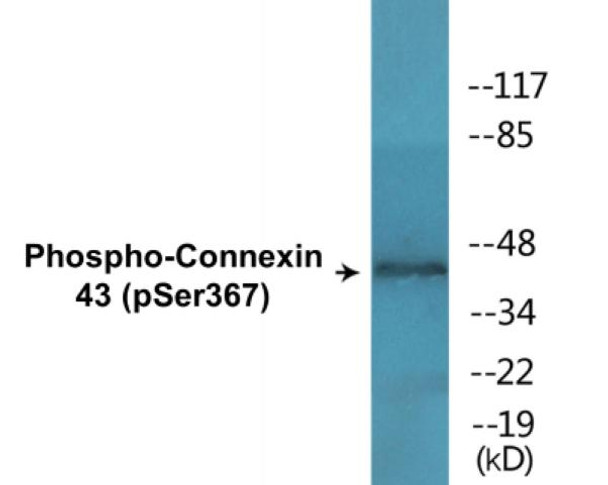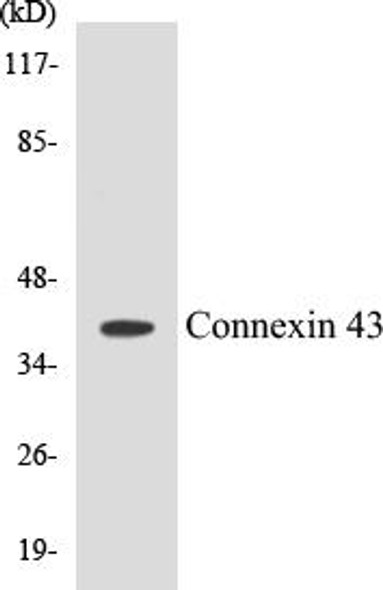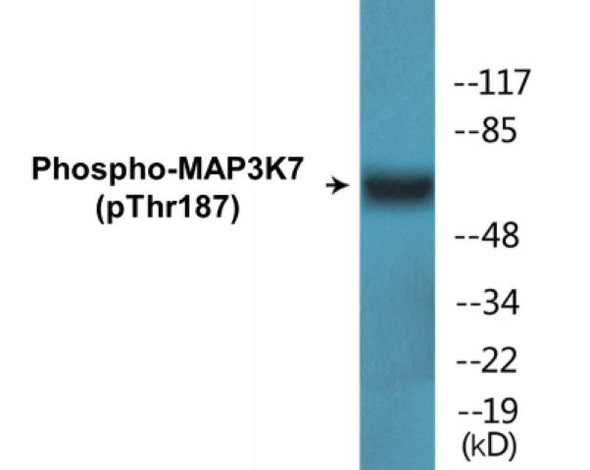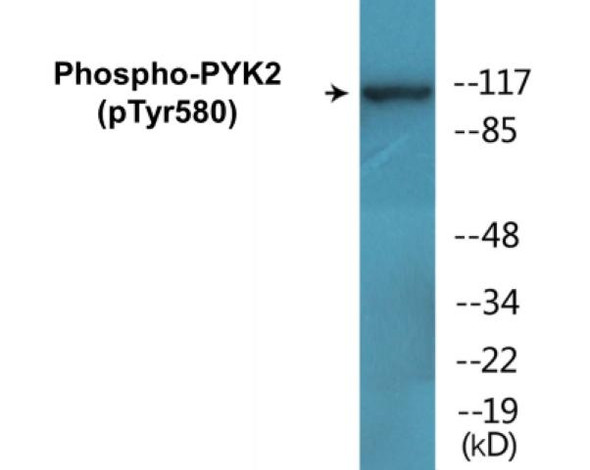Description
Connexin 43 (Phospho-Ser367)Colorimetric Cell-Based ELISA Kit
The Connexin-43 Phospho-Ser367 Colorimetric Cell-Based ELISA Kit is a comprehensive and reliable tool for studying the phosphorylation status of Connexin-43 at Serine 367 in cell-based assays. This kit is specifically designed for the accurate detection and quantification of Connexin-43 phosphorylation levels in cell lysates, making it an essential tool for researchers studying cell signaling pathways and intercellular communication.Connexin-43 is a critical component of gap junctions, playing a crucial role in mediating direct cell-to-cell communication and maintaining tissue homeostasis. Phosphorylation at specific sites, such as Serine 367, can modulate the function and localization of Connexin-43, impacting various cellular processes.
With high sensitivity and specificity, the Connexin-43 Phospho-Ser367 Colorimetric Cell-Based ELISA Kit ensures accurate and reproducible results, enabling researchers to gain valuable insights into the role of Connexin-43 phosphorylation in different cellular contexts. This kit is a valuable resource for studying the molecular mechanisms underlying gap junction regulation and its implications in various physiological and pathological conditions.
| Product Name: | Connexin 43 (Phospho-Ser367) Colorimetric Cell-Based ELISA |
| Product Code: | CBCAB01511 |
| ELISA Type: | Cell-Based |
| Target: | Connexin 43 (Phospho-Ser367) |
| Reactivity: | Human, Mouse, Rat |
| Dynamic Range: | > 5000 Cells |
| Detection Method: | Colorimetric 450 nm |
| Format: | 2 x 96-Well Microplates |
The Connexin 43 (Phospho-Ser367) Colorimetric Cell-Based ELISA Kit is a convenient, lysate-free, high throughput and sensitive assay kit that can detect Connexin 43 protein phosphorylation and expression profile in cells. The kit can be used for measuring the relative amounts of phosphorylated Connexin 43 in cultured cells as well as screening for the effects that various treatments, inhibitors (ie. siRNA or chemicals), or activators have on Connexin 43 phosphorylation.
Qualitative determination of Connexin 43 (Phospho-Ser367) concentration is achieved by an indirect ELISA format. In essence, Connexin 43 (Phospho-Ser367) is captured by Connexin 43 (Phospho-Ser367)-specific primary (1ø) antibodies while the HRP-conjugated secondary (2ø) antibodies bind the Fc region of the 1ø antibody. Through this binding, the HRP enzyme conjugated to the 2ø antibody can catalyze a colorimetric reaction upon substrate addition. Due to the qualitative nature of the Cell-Based ELISA, multiple normalization methods are needed:
| 1. | A monoclonal antibody specific for human GAPDH is included to serve as an internal positive control in normalizing the target absorbance values. |
| 2. | Following the colorimetric measurement of HRP activity via substrate addition, the Crystal Violet whole-cell staining method may be used to determine cell density. After staining, the results can be analysed by normalizing the absorbance values to cell amounts, by which the plating difference can be adjusted. |
| Database Information: | Gene ID: 2697, UniProt ID: P17302, OMIM: 121014/164200/186100/241550, Unigene: Hs.74471 |
| Gene Symbol: | GJA1 |
| Sub Type: | Phospho |
| UniProt Protein Function: | GJA1: an integral membrane protein of the connexin family, alpha-type (group II) subfamily. Hexamers of connexin-43 form connexons, which aggregate together to form gap junctions, through which materials of low MW diffuse from one cell to a neighboring cell. May play a critical role in the physiology of hearing by participating in the recycling of potassium to the cochlear endolymph. |
| UniProt Protein Details: | Protein type:Membrane protein, integral; Channel, misc.; Motility/polarity/chemotaxis; Membrane protein, multi-pass Chromosomal Location of Human Ortholog: 6q22.31 Cellular Component: Golgi apparatus; endoplasmic reticulum membrane; focal adhesion; contractile fiber; integral to plasma membrane; lysosome; early endosome; intermediate filament; fascia adherens; cytosol; lipid raft; Golgi membrane; multivesicular body; connexon complex; mitochondrial outer membrane; apical plasma membrane; gap junction; plasma membrane; lateral plasma membrane Molecular Function:protein binding; signal transducer activity; ion transmembrane transporter activity; beta-tubulin binding; SH3 domain binding; gap junction channel activity; receptor binding; PDZ domain binding Biological Process: lens development in camera-type eye; response to peptide hormone stimulus; apoptosis; heart development; neuron migration; milk ejection; positive regulation of vasodilation; signal transduction; elevation of cytosolic calcium ion concentration; muscle contraction; cell-cell signaling; negative regulation of cardiac muscle cell proliferation; positive regulation of glomerular filtration; transport; response to glucose stimulus; positive regulation of striated muscle development; heart looping; ATP transport; adult heart development; chronic inflammatory response; positive regulation of I-kappaB kinase/NF-kappaB cascade; gap junction assembly; in utero embryonic development; epithelial cell maturation; regulation of bone remodeling; positive regulation of insulin secretion; skeletal muscle regeneration; regulation of calcium ion transport; vascular transport; protein oligomerization; osteoblast differentiation; positive regulation of osteoblast differentiation; negative regulation of endothelial cell proliferation; positive regulation of vasoconstriction; positive regulation of protein catabolic process; blood vessel morphogenesis; embryonic digit morphogenesis; regulation of bone mineralization; neurite morphogenesis; response to pH Disease: Syndactyly, Type Iii; Craniometaphyseal Dysplasia, Autosomal Recessive; Palmoplantar Keratoderma And Congenital Alopecia 1; Atrioventricular Septal Defect 3; Oculodentodigital Dysplasia; Erythrokeratodermia Variabilis Et Progressiva; Oculodentodigital Dysplasia, Autosomal Recessive; Hypoplastic Left Heart Syndrome 1 |
| NCBI Summary: | This gene is a member of the connexin gene family. The encoded protein is a component of gap junctions, which are composed of arrays of intercellular channels that provide a route for the diffusion of low molecular weight materials from cell to cell. The encoded protein is the major protein of gap junctions in the heart that are thought to have a crucial role in the synchronized contraction of the heart and in embryonic development. A related intronless pseudogene has been mapped to chromosome 5. Mutations in this gene have been associated with oculodentodigital dysplasia, autosomal recessive craniometaphyseal dysplasia and heart malformations. [provided by RefSeq, May 2014] |
| UniProt Code: | P17302 |
| NCBI GenInfo Identifier: | 117706 |
| NCBI Gene ID: | 2697 |
| NCBI Accession: | P17302.2 |
| UniProt Secondary Accession: | P17302,Q6FHU1, Q9Y5I8, B2R5U9, |
| UniProt Related Accession: | P17302 |
| Molecular Weight: | 382 |
| NCBI Full Name: | Gap junction alpha-1 protein |
| NCBI Synonym Full Names: | gap junction protein, alpha 1, 43kDa |
| NCBI Official Symbol: | GJA1 |
| NCBI Official Synonym Symbols: | HSS; CMDR; CX43; GJAL; ODDD; AVSD3; HLHS1 |
| NCBI Protein Information: | gap junction alpha-1 protein; connexin 43; connexin-43; gap junction 43 kDa heart protein |
| UniProt Protein Name: | Gap junction alpha-1 protein |
| UniProt Synonym Protein Names: | Connexin-43; Cx43; Gap junction 43 kDa heart protein |
| Protein Family: | Gap junction alpha-1 protein |
| UniProt Gene Name: | GJA1 |
| UniProt Entry Name: | CXA1_HUMAN |
| Component | Quantity |
| 96-Well Cell Culture Clear-Bottom Microplate | 2 plates |
| 10X TBS | 24 mL |
| Quenching Buffer | 24 mL |
| Blocking Buffer | 50 mL |
| 15X Wash Buffer | 50 mL |
| Primary Antibody Diluent | 12 mL |
| 100x Anti-Phospho Target Antibody | 60 µL |
| 100x Anti-Target Antibody | 60 µL |
| Anti-GAPDH Antibody | 60 µL |
| HRP-Conjugated Anti-Rabbit IgG Antibody | 12 mL |
| HRP-Conjugated Anti-Mouse IgG Antibody | 12 mL |
| SDS Solution | 12 mL |
| Stop Solution | 24 mL |
| Ready-to-Use Substrate | 12 mL |
| Crystal Violet Solution | 12 mL |
| Adhesive Plate Seals | 2 seals |
The following materials and/or equipment are NOT provided in this kit but are necessary to successfully conduct the experiment:
- Microplate reader able to measure absorbance at 450 nm and/or 595 nm for Crystal Violet Cell Staining (Optional)
- Micropipettes with capability of measuring volumes ranging from 1 µL to 1 ml
- 37% formaldehyde (Sigma Cat# F-8775) or formaldehyde from other sources
- Squirt bottle, manifold dispenser, multichannel pipette reservoir or automated microplate washer
- Graph paper or computer software capable of generating or displaying logarithmic functions
- Absorbent papers or vacuum aspirator
- Test tubes or microfuge tubes capable of storing ≥1 ml
- Poly-L-Lysine (Sigma Cat# P4832 for suspension cells)
- Orbital shaker (optional)
- Deionized or sterile water
*Note: Protocols are specific to each batch/lot. For the correct instructions please follow the protocol included in your kit.
| Step | Procedure |
| 1. | Seed 200 µL of 20,000 adherent cells in culture medium in each well of a 96-well plate. The plates included in the kit are sterile and treated for cell culture. For suspension cells and loosely attached cells, coat the plates with 100 µL of 10 µg/ml Poly-L-Lysine (not included) to each well of a 96-well plate for 30 minutes at 37 °C prior to adding cells. |
| 2. | Incubate the cells for overnight at 37 °C, 5% CO2. |
| 3. | Treat the cells as desired. |
| 4. | Remove the cell culture medium and rinse with 200 µL of 1x TBS, twice. |
| 5. | Fix the cells by incubating with 100 µL of Fixing Solution for 20 minutes at room temperature. The 4% formaldehyde is used for adherent cells and 8% formaldehyde is used for suspension cells and loosely attached cells. |
| 6. | Remove the Fixing Solution and wash the plate 3 times with 200 µL 1x Wash Buffer for five minutes each time with gentle shaking on the orbital shaker. The plate can be stored at 4 °C for a week. |
| 7. | Add 100 µL of Quenching Buffer and incubate for 20 minutes at room temperature. |
| 8. | Wash the plate 3 times with 1x Wash Buffer for 5 minutes each time. |
| 9. | Add 200 µL of Blocking Buffer and incubate for 1 hour at room temperature. |
| 10. | Wash 3 times with 200 µL of 1x Wash Buffer for 5 minutes each time. |
| 11. | Add 50 µL of 1x primary antibodies Anti-Connexin 43 (Phospho-Ser367) Antibody, Anti-Connexin 43 Antibody and/or Anti-GAPDH Antibody) to the corresponding wells, cover with Parafilm and incubate for 16 hours (overnight) at 4 °C. If the target expression is known to be high, incubate for 2 hours at room temperature. |
| 12. | Wash 3 times with 200 µL of 1x Wash Buffer for 5 minutes each time. |
| 13. | Add 50 µL of 1x secondary antibodies (HRP-Conjugated AntiRabbit IgG Antibody or HRP-Conjugated Anti-Mouse IgG Antibody) to corresponding wells and incubate for 1.5 hours at room temperature. |
| 14. | Wash 3 times with 200 µL of 1x Wash Buffer for 5 minutes each time. |
| 15. | Add 50 µL of Ready-to-Use Substrate to each well and incubate for 30 minutes at room temperature in the dark. |
| 16. | Add 50 µL of Stop Solution to each well and read OD at 450 nm immediately using the microplate reader. |
(Additional Crystal Violet staining may be performed if desired – details of this may be found in the kit technical manual.)






